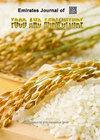土耳其北部黑海地区本地葡萄(Vitis labrusca L.)基因型物候、形态和遗传特征
IF 0.7
4区 农林科学
Q3 AGRONOMY
引用次数: 0
摘要
在土耳其北部的黑海地区,拉布鲁斯卡葡萄已被广泛归化。本研究的目的是评价黑海地区近三个生长季节生长的紫花苜蓿的形态、物候和遗传特征。根据国际葡萄和葡萄组织(OIV)的地形描述描述,描述了当地的基因型,包括茎长(cm)、成熟叶大小、束长和宽度、浆果长和宽度、浆果重量、浆果数量、总可溶性固形物(TTS)和可滴定酸度。此外,还记录了物候数据,包括发芽、开花、品种和收获日期。利用ISSR (Inter Simple Sequence Repeat)标记对所选材料进行了分子水平的鉴定和亲缘关系分析。6条ISSR引物共获得77条条带,其中多态性69条,平均多态性率为88.68%。这些ISSR引物产生的多态性信息含量(PIC)值在0.48 ~ 0.5之间。基因型间遗传相似性为0.08 ~ 0.83。基于ISSR分析的树状图显示,8号和5号基因型亲缘关系较好,相似系数为0.83,3号基因型亲缘关系最远,相似系数为0.08。结果表明,ISSR标记可用于油菜基因型间的遗传多样性分析。我们的研究结果还描述了新的labrusca基因型的特征,这些特征可能对未来的标记辅助选择(MAS)和葡萄育种有价值。关键词:多样性,狐种,ISSRs,育种,多态性本文章由计算机程序翻译,如有差异,请以英文原文为准。
Phenological, morphological and genetic characterization of local grapevine (Vitis labrusca L.) genotypes grown in the Black Sea Region in Northern Turkey
Vitis labrusca has become widely naturalized in the Black Sea region of Northern Turkey. The aim of this work was to evaluate the morphological, phenological, and genetic characteristics of V. labrusca accessions grown in the Black Sea region during the last three growing seasons. Local genotypes were described according to the Organisation Internationale de la Vigne et du Vin (OIV) ampelographic descriptor, including shoot length (cm), mature leaf size, bunch length and width, berry length and width, berry weight, number of berries, Total Soluble Solids (TTS) and titratable acidity. Additionally, phenological data, including bud burst, flowering, veraison and harvest date, were recorded. The accessions were characterized at the molecular level, and genetic relationships were assessed by means of Inter Simple Sequence Repeat (ISSR) markers. Using 6 ISSR primers, seventy-seven bands were obtained, of which 69 were polymorphic with a mean polymorphic rate of 88.68%. These ISSR primers produced polymorphism information content (PIC) values ranging from 0.48 to 0.5. The genetic similarity ranged from 0.08 to 0.83 among the genotypes. According to the dendrogram based on the ISSR analysis, Accessions 8 and 5 were genetically related, with a coefficient of similarity of 0.83, while Accession 3 was the most distantly related genotype, with a coefficient of similarity of 0.08. These results demonstrated that ISSR markers can be used for genetic diversity analysis among V. labrusca genotypes. Our results also described characteristics of new V. labrusca genotypes that could be valuable for future Marker-Assisted Selection (MAS) and grapevine breeding.
Key words: Diversity, foxy species, Inter-Simple Sequence Repeat markers (ISSRs), Breeding, polymorphism
求助全文
通过发布文献求助,成功后即可免费获取论文全文。
去求助
来源期刊

Emirates Journal of Food and Agriculture
AGRONOMYFOOD SCIENCE & TECHNOLOGY&nb-FOOD SCIENCE & TECHNOLOGY
CiteScore
1.80
自引率
0.00%
发文量
18
期刊介绍:
The "Emirates Journal of Food and Agriculture [EJFA]" is a unique, peer-reviewed Journal of Food and Agriculture publishing basic and applied research articles in the field of agricultural and food sciences by the College of Food and Agriculture, United Arab Emirates University, United Arab Emirates.
 求助内容:
求助内容: 应助结果提醒方式:
应助结果提醒方式:


